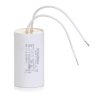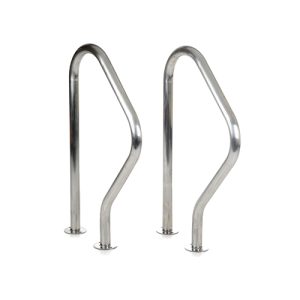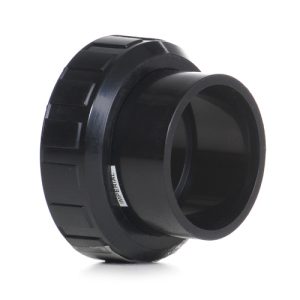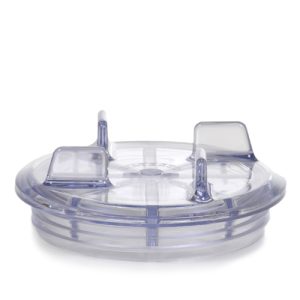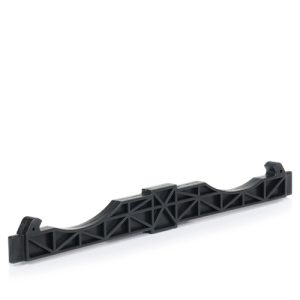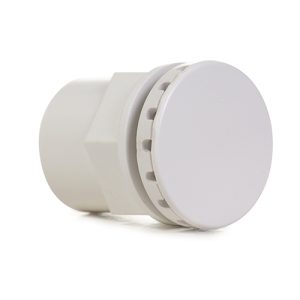Aquamite 0.75hp / Supastream 0.75hp / 1.00hp Pump Capacitor (71 Frame Motor) 20UF
£68.00 Inc VAT
1 in stock
Aquamite 0.75hp / Supastream 0.75hp / 1.00hp Pump Capacitor (71 Frame Motor) 20UF
Critical Starting Component for Higher Horsepower Motors
As a retailer of pool and spa parts, I stock this replacement run capacitor for Aquamite 0.75hp and Supastream 0.75hp/1.00hp pumps equipped with 71 frame motors. This 20UF (microfarad) capacitor is essential for motor starting and efficient operation—without it, your pump cannot run.
What is a Motor Capacitor?
A capacitor is an electrical component that stores and releases energy to help single-phase motors start and operate efficiently. The 20UF rating indicates this capacitor’s storage capacity, specifically matched to the higher electrical demands of 0.75hp and 1.00hp motors used in these pump models.
This larger capacity compared to smaller motor capacitors (like the 12.5MF units for 0.33hp/0.50hp motors) reflects the increased power requirements of higher horsepower motors. More powerful motors need greater starting torque, which requires capacitors with higher microfarad ratings.
The capacitor connects electrically to the motor’s start winding, creating a phase shift that generates the rotating magnetic field necessary for single-phase motor operation. This phase shift provides the torque needed to overcome inertia and get the heavy impeller and water load spinning.
How Capacitors Enable Motor Starting
Single-phase motors face an inherent challenge—they receive alternating current that reverses direction 50 or 60 times per second (depending on your electrical system), but this alone doesn’t create rotation. The capacitor solves this by storing electrical charge and releasing it at precisely the right moment in the AC cycle.
This creates a second magnetic field that’s offset in time from the main winding’s field. The interaction between these two out-of-phase fields produces a rotating magnetic field that starts the rotor spinning. Once rotating, the motor generates enough torque to continue running even if the capacitor weakens, though efficiency drops significantly.
In run capacitor applications (standard for pool pump motors), the capacitor remains energized during operation, continuously improving power factor and motor efficiency. This reduces electrical consumption, decreases motor heating, and provides quieter operation.
Signs Your Capacitor Has Failed
A motor that hums loudly but won’t start is the classic symptom of capacitor failure. You’ll hear the electrical hum indicating power reaches the motor, but the shaft remains stationary. Without the capacitor’s assistance, the motor cannot generate sufficient starting torque to overcome the impeller load.
Hard starting, where the motor labours for several seconds before reaching full speed, indicates a weakening capacitor losing capacity. The motor eventually starts but works much harder than designed, shortening its lifespan through excessive heat and stress.
The pump may start on some attempts but not others, particularly showing intermittent behaviour related to temperature. Failing capacitors often work when cool but fail when warm, or they may function briefly before overheating and failing mid-operation.
Motors running excessively hot or drawing higher than normal current often have failed run capacitors. Without the capacitor’s efficiency improvement, the motor compensates by drawing more current, generating additional heat that can trigger thermal overload shutdowns.
Physical signs include a bulging case, fluid leaking from the capacitor body, or swelling that makes the normally cylindrical case appear distorted. These symptoms indicate internal breakdown and imminent complete failure.
Why Capacitors Fail
Age is the primary cause—capacitors contain internal components that gradually degrade through normal use. Most capacitors last 5-10 years depending on operating conditions, with continuous-duty applications wearing them faster than intermittent use.
Heat dramatically accelerates capacitor failure. Motors running in hot environments, operating continuously during summer, or working under heavy loads generate heat that radiates to nearby components. Poor ventilation around the motor compounds this problem by preventing heat dissipation.
Electrical stress from voltage fluctuations damages capacitors. Power surges from lightning, utility switching operations, or generator startups create voltage spikes that exceed the capacitor’s rated limits. Even small surges accumulate damage over time.
Frequent motor cycling (starting and stopping) stresses capacitors since each start demands maximum performance. Pumps controlled by timers that cycle multiple times daily wear capacitors faster than pumps running continuously.
Moisture exposure corrodes terminals and can penetrate the capacitor housing, causing internal component degradation. Pumps in damp locations or areas with heavy condensation face accelerated capacitor failure.
Testing and Diagnosis
Safety First: Always discharge capacitors before touching terminals—they store dangerous electrical charge even after power disconnection. Use an insulated screwdriver to carefully short the terminals together, or use a proper capacitor discharge tool.
A multimeter with capacitance measurement capability can test the actual value against the 20UF rating. Readings more than 10% below specification (under approximately 18UF) indicate the capacitor has degraded and requires replacement.
Visual inspection reveals many failures without testing. Bulging cases, leaking dielectric fluid, corroded or burnt terminals, or discoloration around the capacitor all indicate failure requiring immediate replacement.
A simple diagnostic test: if the motor hums but won’t start, try carefully “spin starting” by quickly rotating the pump shaft or impeller (with power on—be extremely careful of the spinning components). If the motor then runs, this confirms capacitor failure since you’ve manually provided the starting torque the capacitor should supply.
Correct Replacement Specifications
The replacement capacitor must match both the capacitance rating (20UF) and voltage rating of the original. Using incorrect values prevents proper motor operation and may damage the motor or create safety hazards.
Higher voltage ratings (like 370V or 440V) are acceptable substitutes if the exact voltage isn’t available, but never use lower voltage ratings than specified. The capacitance, however, must match closely—variations of more than 10% affect motor performance.
Physical size and terminal configuration should match to ensure proper mounting and connection. While electrical specifications are paramount, a capacitor that doesn’t fit creates installation difficulties and may not mount securely.
Quality varies significantly between manufacturers. Premium capacitors from reputable brands cost more but provide longer service life and more reliable performance. Cheap capacitors often fail prematurely, creating repeated replacement costs and inconvenience.
Safe Installation Procedures
Disconnect all power at the circuit breaker before working on motor electrical components. Use a voltage tester to verify power is off—never rely solely on breaker position or switches.
Discharge the old capacitor completely before touching any terminals. Capacitors can retain dangerous charge for hours or even days after power removal.
Photograph wire connections before disconnecting the old capacitor if you’re uncertain about the configuration. Incorrect wiring can damage the motor or create electrical hazards. Most capacitors have clearly marked terminals—common, start, and sometimes run—that must connect correctly.
Secure the new capacitor mounting bracket firmly to prevent vibration damage. Loose mounting allows the capacitor to shake during operation, potentially breaking connections or cracking the case.
Route wires away from hot motor surfaces and moving parts. Use appropriate wire ties to secure connections and maintain proper clearances. Ensure no bare wires can contact the motor frame or other grounded surfaces.
Compatibility and Application
This 20UF capacitor is engineered for Aquamite 0.75hp pumps and Supastream 0.75hp/1.00hp pumps equipped with 71 frame motors. The higher capacitance compared to smaller motor capacitors reflects the increased power requirements and starting torque needs of these larger motors.
These mid-range pumps are extremely popular in residential pool installations, providing the flow rates needed for effective filtration in medium to large pools. The capacitor is consequently a frequently needed replacement component.
Product Specifications
| Specification | Details |
|---|---|
| Product Type | Motor Run Capacitor |
| Compatibility | Aquamite 0.75hp; Supastream 0.75hp/1.00hp (71 frame motor) |
| Capacitance | 20 Microfarads (UF/μF) |
| Function | Enables motor starting and improves running efficiency |
| Application | Single-phase pump motors |
| Motor Frame | 71 frame motors |
| Mounting | External motor housing mount |
| Weight | 0.09 kg |
| Dimensions (L × W × H) | 0.1 m × 0.15 m × 0.15 m |
| Volume | 0.002 cubic meters |
| SKU | 6497240479 |
| Category | Pool & Spa Spares |
Preventive Maintenance
Inspect capacitors during routine pump maintenance. Look for early warning signs like slight bulging, minor corrosion, or discoloration that indicate developing problems. Replacing a weakening capacitor before complete failure prevents inconvenient mid-season breakdowns.
Maintain good ventilation around the motor to reduce operating temperatures. Cooler motors extend capacitor life significantly. Keep motor cooling fins clean and ensure adequate clearance around the pump for airflow.
Consider proactive capacitor replacement every 5-7 years regardless of apparent condition. This preventive approach is more convenient than dealing with unexpected failures during peak pool season when replacement parts may be harder to source.
Protect outdoor pumps from excessive weather exposure. While pump motors are rated for outdoor service, minimizing direct exposure to rain, snow, and intense sunlight extends component life. Simple pump covers or shelters provide effective protection.
After electrical storms or significant power disturbances, test pump operation. Surge damage may weaken capacitors without causing immediate failure, but the weakened component will fail soon afterward. Early detection through testing allows replacement on your schedule rather than during an emergency.
This essential electrical component ensures reliable motor starting and efficient operation, making it a critical spare part for maintaining uninterrupted pool circulation throughout the swimming season.
| Weight | 0.09 Kilograms |
|---|---|
| Length | 0.1 Meters |
| Width | 0.15 Meters |
| Height | 0.15 Meters |
| Volume | 0.002 CubicMeters |
| Supplier | GoldenC |
Related products
Spares
Spares


